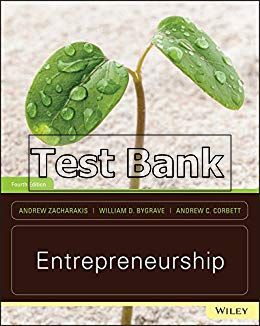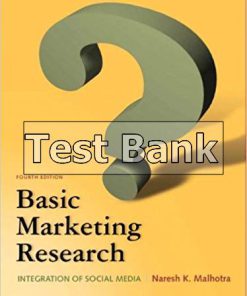Entrepreneurship 4th Edition Zacharakis Test Bank
You may also like
-
$26.50
$50.00 -
$26.50
$50.00
Entrepreneurship 4th Edition Zacharakis Test Bank

Product details:
- ISBN-10 : 1119563224
- ISBN-13 : 978-1119563228
- Author: Andrew Zacharakis
Entrepreneurship, 5th Edition helps aspiring entrepreneurs understand the process of starting a new venture and appreciate the vital role of entrepreneurship in the economy. This accessible textbook explains the steps involved in starting a new company, and offers insights on engaging with startups as investors, bankers, accountants, lawyers, vendors, customers, and employees. Delving into the real-world trials and tribulations of entrepreneurship, the text covers every stage of the entrepreneurial process, from searching for an opportunity and molding it into an attractive product or service, to launching, growing, and eventually harvesting the new venture.
The fully revised and updated fifth edition integrates core concepts of entrepreneurship and practical case studies―enabling students to develop an inclusive perspective on how businesses are born, grow, and succeed or fail. The authors explore the entrepreneurial competitiveness of nations throughout the world, describe the critical factors for starting a new enterprise and building it into a successful business, and demonstrate how to build a workable business model. Clear, straightforward chapters cover each essential area of entrepreneurship, including marketing, strategy, team building, financial projections, business planning, and more.
Table contents:
- Chapter 1: The Power of Entrepreneurship
- Entrepreneurship and Small Business in the United States
- Causes of the Entrepreneurial Revolution
- Global Entrepreneurship Monitor
- Principal Findings from GEM
- Entrepreneurship Ecosystems and the Importance of Support
- Conclusion
- Your Opportunity Journal
- Web Exercise
- Notes
- Case: Alison Barnard
- Chapter 2: The Entrepreneurial Process
- Critical Factors for Starting a New Enterprise
- Evaluating Opportunities for New Businesses
- Determining Resource Needs and Acquiring Resources
- Profit Potential
- Ingredients for a Successful New Business
- Conclusion
- Your Opportunity Journal
- Web Exercise
- Notes
- Case: Vera Bradley
- Chapter 3: Opportunity Recognition, Shaping, and Reshaping
- From Glimmer to Action: How Do I Come Up with a Good Idea?
- Is Your Idea an Opportunity?
- The Opportunity Checklist
- “I Don’t Have an Opportunity”
- Conclusion
- Your Opportunity Journal
- Web Exercise
- Notes
- Case: Jim Poss
- Chapter 4: Prototyping Your Ideas
- What Is Prototyping?
- Types of Prototyping
- Conclusion
- Your Opportunity Journal
- Web Exercise
- Notes
- Case: Balanced Snacking
- Chapter 5: Understanding Your Business Model and Developing Your Strategy
- The Business Model
- The First‐Mover Myth
- Formulating a Winning Strategy
- Conclusion
- Your Opportunity Journal
- Web Exercise
- Notes
- Case: Zumba Fitness
- Chapter 6: Entrepreneurial Marketing
- Why Marketing Is Critical for Entrepreneurs
- Entrepreneurs Face Unique Marketing Challenges
- Acquiring Market Information
- Marketing Strategy for Entrepreneurs
- Guerrilla Marketing
- Marketing Skills for Managing Growth
- Conclusion
- Your Opportunity Journal
- Web Exercise
- Appendix: Customer Interview
- Notes
- Case: Theo Chocolate
- Appendix: 1 Background and Explanations of Organic and Fair Trade in the Chocolate Industry
- Chapter 7: Building the Founding Team
- Power of the Team
- Where Do You Fit?
- How to Build a Powerful Team
- Bootstrapping: Building the Team Based on Stage‐of‐Venture Life
- Compensation
- External Team Members
- Keeping the Team Together
- Conclusion
- Your Opportunity Journal
- Web Exercise
- Notes
- Case: Box, Inc.: Preserving Startup Culture in a Rapidly Growing Company
- Chapter 8: The Business Planning Process
- The Planning Process
- The Story Model
- The Business Plan
- Types of Plans
- Style Pointers for the Written Plan and Oral Presentation
- Conclusion
- Your Opportunity Journal
- Web Exercise
- Notes
- Case: P’Kolino
- Chapter 9: Building Your Pro Forma Financial Statements
- Common Mistakes
- Financial Statement Overview
- Building Your Pro Forma Financial Statements
- Comparable Method
- Building Integrated Financial Statements
- Putting It All Together
- Conclusion
- Your Opportunity Journal
- Web Exercise
- Notes
- Case: P’Kolino Financials
- Chapter 10: Financing Entrepreneurial Ventures Worldwide
- Entrepreneurial Financing for the World’s Poorest
- Entrepreneurs and Informal Investors
- Crowdfunding
- Venture Capital
- Conclusion
- Your Opportunity Journal
- Web Exercise
- Notes
- Case: Crowdfunding: A Tale of two Campaigns
- Chapter 11: Raising Money for Starting and Growing Businesses
- Jim Poss, BigBelly Solar
- Bootstrapping New Ventures
- Valuation
- Financing a New Venture
- Harvesting Investments
- Conclusion
- Your Opportunity Journal
- Web Exercise
- Notes
- Case: Metacarta: Growing A Company, Do We Take The Vc Money?
- Chapter 12: Debt and Other Forms of Financing
- Getting Access to Funds—Start with Internal Sources
- Cash Conversion Cycle
- Working Capital: Getting Cash from Receivables and Inventories
- Using Accounts Receivable as Working Capital
- Sources of Short‐Term Cash: More Payables, Less Receivables
- Obtaining Bank Loans Through Accounts Receivable Financing
- Obtaining Loans against Inventory
- Obtaining “Financing” from Customer Prepayments
- Choosing the Right Mix of Short‐Term Financing
- Traditional Bank Lending: Short‐Term Bank Loans
- Equipment Financing
- Obtaining Early Financing from External Sources
- Conclusion
- Your Opportunity Journal
- Web Exercise
- Notes
- Case: Feed Resource Recovery
- Chapter 13: Legal and Tax Issues, Including Intellectual Property
- Why, When, and How to Choose an Attorney
- Leaving Your Present Position
- Intellectual Property
- Choice of Legal Form
- Choosing a Name
- Legal and Tax Issues in Hiring Employees
- Raising Money
- Conclusion
- Your Opportunity Journal
- Web Exercise
- Notes
- Case: Tessera
- Chapter 14: Entrepreneurial Growth
- Making the Transition from Startup to Growth
- A Model of Driving Forces of Growth
- The Growth Process
- Execution
- Opportunity Domain
- Organizational Resources and Capabilities
- Leadership
- Conclusion
- Your Opportunity Journal
- Web Exercise
- Notes
- Case: Lazybones
- Chapter 15: Social Entrepreneurship
- Introduction
- The Rise in Social Entrepreneurship
- Social Entrepreneurship Defined
- A Social Entrepreneurship Typology
- Measuring Impact
- Conclusion
- Your Opportunity Journal
- Web Exercise
- Notes
- Case: Year Up: Workforce Training for Urban Youth
- Glossary
- Index
- End User License Agreement
People also search:
bamford entrepreneurship 4th edition
corporate entrepreneurship and innovation (4th edition) pdf
entrepreneurship a south african perspective 4th edition
entrepreneurship books for beginners
explain four characteristics of entrepreneurship












